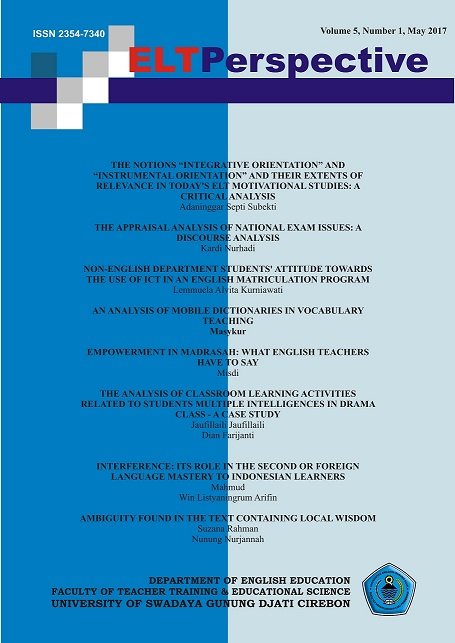Ambiguity Found in the Text Containing Local Wisdom
DOI:
https://doi.org/10.33603/perspective.v5i1.554Abstract
Theories of semantics ‘ interpretation of meanings are not only discussing about speakers’ meaning and word or sentence meaning.They are also influenced by ambiguity.    Ambiguity can cause different interpretation of meanings. One of the problems is caused byone has more than one meaning. The aim of this research entitled : “The Analysis of Ambiguity Found in the Texts containing Local Wisdomâ€.  is to find out lexical ambiguity in the texts containing local wisdom. The choice of the texts can be in the form of brochures of some tourism objects  around Cirebon, or the hystorical background of Cirebon and some other places of The Area III of Cirebon and Ciayu Maja Kuning. This research is regarded to be important due to the effect of ambiguity that can cause mis interpretation of meaning that will cause misunderstanding. The term lexical ambiguity follows the theories of Fromkin et.al (2002) and Kent Bach (2009). The data is taken from those texts that have been previously stated, then all the data willl be analyzed to know the type and occurence of the usage in those texts.After that the way how to disambiguate them will be described. The research method that is used in this research is descriptive qualitative from Creswell (1994).Findings : The words classes found to be ambiguous were: 46.6 % Nouns;  33.33 % Adjectives; 6.66% Verb; 6.66% Adverb. It also means that its occurances of ambiguites were mostly in nouns, adjectives, verb and adverb. The way to disambiguate the ambiguous words mostly by giving additional information required to clarify the meanings of those words in order to avoid ambiguity; only one using picture. Almost all the ambiguities were caused by having multiple meanings that are also called polysemious. Other researchers who are interested toknow more about ambiguity can use other kind of texts to elaborate the findings.
Keywords: ambiguity, local wisdom content-text, lexicalÂReferences
Bach, Kent. 2009. “Ambiguity and Types of ambiguityâ€routledge Encyclopaedia of Phylosophy Entry. Retrieved on September 2015.
Bungin, Burhan. 2001. Metodologi Penelitian Sosial: Format-Format Kuantitatif dann Kualitatif.
Cowie. A. P. 1999. “Introduction to Language Study : Semantics.†Oxford University Press.
Cresswell, John. W. 1994. Research Design: Qualitative & Quantitative Approaches, SAGE Publication Inc. California.
Fraenkel & Wallen. 2003.How to Desisgn And Evaluate Research Question in Education. Mc. Graw Hill. New York.
Fromkin, Victoria and Rodman Robert et. al. 1994:â€An Introduction to Language.†Holt Reinhart And winston Inc. North Carolina State University, Fourth edition.
Hindle, David & Rooth Mats, 1993. Structural Ambiguity and Lexical Relations. Association for Computational Linguistics. Washington D.C.
Jarvella, Sanna & simone, Volet .2001. Motivation in Learning Contexts: Theoretical Advances and Methodological Implications. British Cataloguing in Publication Data. U. K.
Kamahani G., and Tahirov , M. Ilham. 2013.â€Focus on Structural and Lexical Ambiguity in English Newspaper headlines Written by Native and non-NativeJournalists : A contrastive Study.â€Mediteranean Journal of Social Sciences. Retrieved on 31 August 2015
Kapadia, Dimple and Jufrizal; “Types of Ambiguity Found in The editorials of Jakarta Post Daily Newspaper “English Language and Literature E-Journal/ISSN 2302-3546. Retrieved on September 2015.
Kovak,, Smljana Narancic. Learning english and Understanding Literature. ELT Confrencefor Teachers of English To Young Learners.36-41.
Kreidler, C.W,; 2002. “Introducing English Semantics†Routledge, New York.
Kristianty, Susan. 2006. “The Structural and Lexical Ambiguity Found in Cleo Magazine.†Unpublished Thesis. Jakarta; Universitas Kristen Patra. Retrieved in September 2015.
Lodico, G. Marguerite; Spaulding, T. Dean; Voegetle, H. Katherine. 2006. Methods in Educational Research; from Theory to Practice. Jossey-Bass. USA, San Fransisco.
Lambert, Mike. 2012. A Beginner’s Guide to Doing Your Research Project. SAGE Publication Inc. California.
Lang, Marguirieta G., et al. 2006. Methods in Educational Research. From Theory to Practice. Jossey-Bass. USA.
Lii, Thereaaa12, English 60,2009. Defining Charaters by Their Chosen Environ ment. Brown University.
http:// www.victorianweb.org/dickens/ge/lii6.html.
McDonald, C., Maryellen et.al. 1994. “Lexical Nature of Ambiguity Resolutionâ€. The American Psychological association inc. 0033-295X/94. Rerrieved on September 2015.
Menache, Lionel. 2001. Writing A Research Paper. The University of Michigan Press. USA.
Nunan, David., 2003. Practical English Language Teaching. First Edition.Mc., Graw Hill Companies. New York.
Pramitasih, Atik.et.al., A Study on Ambiguity Found in English Exercises of Vocational School Student’s Exercise Books. School of Teacher Training and education, Muhammadiyah University of Surakarta.
Spivey, Michael and Tanenhause. K., Michael. 1998. “Syntactic Ambiguity Resolution in Discourse: Modelling the Effects of referential context and lexical frequency.â€An Article in Journal of experimental Psychology Learning Memory nd Cognition. Retrieved on 02 August 2015.
Weigle, Sara Cushing. 2002. Assasing Writing. Cambridge University Press.
Downloads
Published
How to Cite
Issue
Section
Citation Check
License
- Authors retain copyright and grant the journal right of first publication with the work simultaneously licensed under a Creative Commons Attribution - Share Alike 4.0 Internasional License (CC-BY-SA) that allows others to share the work with an acknowledgment of the works' authorship and initial publication in this journal.
- Authors are able to enter into separate, additional contractual arrangements for the non-exclusive distribution of the journals published version of the work (e.g., post it to an institutional repository or publish it in a book), with an acknowledgement of its initial publication in this journal.
- Upon receiving the proofs, the Author/Editor agrees to promptly check the proofs carefully, correct any errors, and authorize the publication of the corrected proofs.
- Authors should submit the signed copyright transfer agreement form (CTA Form) along with the checked (and corrected proofs).










